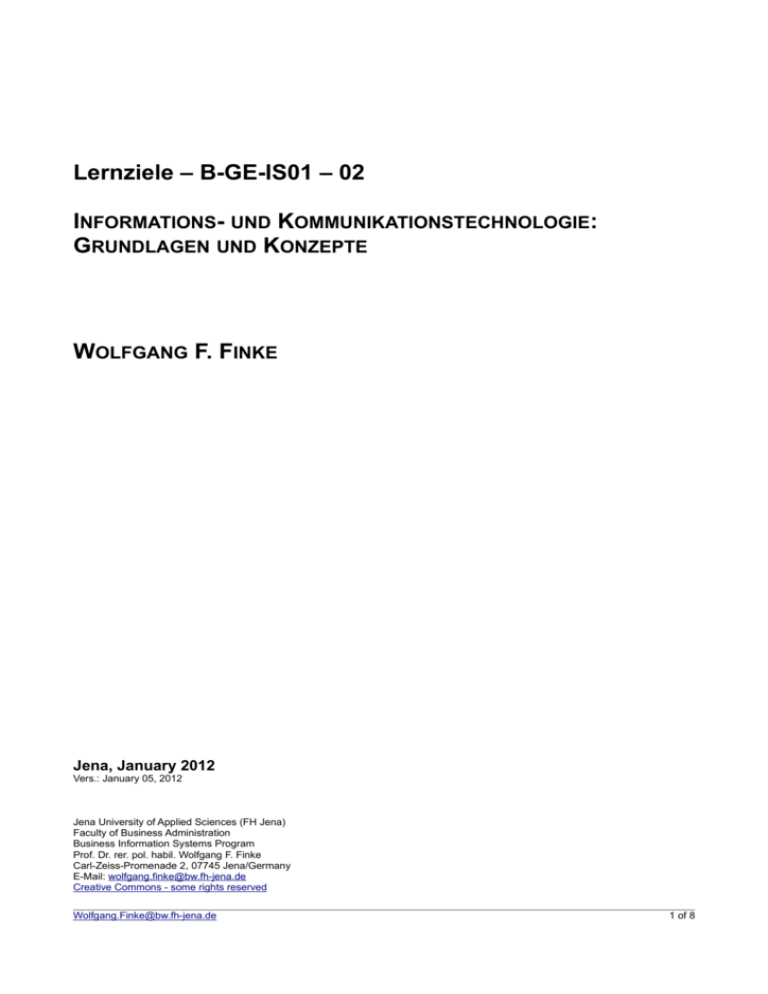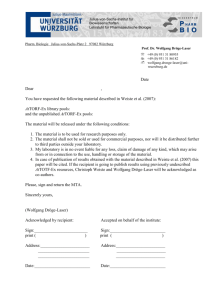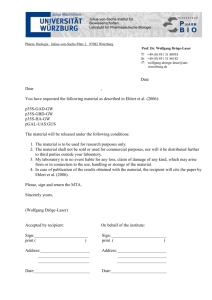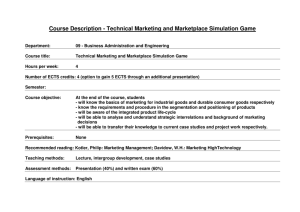
Lernziele – B-GE-IS01 – 02
INFORMATIONS- UND KOMMUNIKATIONSTECHNOLOGIE:
GRUNDLAGEN UND KONZEPTE
WOLFGANG F. FINKE
Jena, January 2012
Vers.: January 05, 2012
Jena University of Applied Sciences (FH Jena)
Faculty of Business Administration
Business Information Systems Program
Prof. Dr. rer. pol. habil. Wolfgang F. Finke
Carl-Zeiss-Promenade 2, 07745 Jena/Germany
E-Mail: wolfgang.finke@bw.fh-jena.de
Creative Commons - some rights reserved
Wolfgang.Finke@bw.fh-jena.de
1 of 8
Lernziele – B-GE-IS01 – 02
Informations- und Kommunikationstechnologie: Grundlagen und
Konzepte
Lehrveranstaltung im Bachelor's Programm – FB BW – FH Jena
Grundlage der Lehrveranstaltung ist das Textbuch (Kapital 1 - 12) „Introduction to Information Systems“ von O'Brien/Marakas (McGraw-Hill) jeweils in der neuesten Auflage und die darin formulierten Lernziele.
Das o.g. Textbuch ist seit inzwischen mehr als zehn Jahren für die Lehrveranstaltung eingeführt
und gehört zu den weltweit führenden Textbüchern für eine “Einführung in die Wirtschaftsinformatik”. Zudem bietet der Verlag – über eine WebSite – zusätzliche Materialien und aktivitäten für Studenten an.
http://highered.mcgraw-hill.com/sites/0073376779/information_center_view0/
Table of Contents
Foundations of Information Systems in Business.............................................................................2
Competing with Information Technology...........................................................................................3
Computer Hardware......................................................................................................................... 3
Computer Software.......................................................................................................................... 4
Data Resource Management............................................................................................................4
Telecommunicationsand Networks...................................................................................................5
e-Business Systems......................................................................................................................... 5
E-Commerce Systems..................................................................................................................... 6
Decision Support Systems............................................................................................................... 6
Developing Business/IT Solutions....................................................................................................7
Security and Ethical Challenges.......................................................................................................7
Enterprise and Global Management of Information Technology.......................................................8
Lernziele (entnommen aus dem o.g. Textbuch)
Foundations of Information Systems in Business
Chapter 1
Learning Objectives
•
Understand the concept of a system and how it relates to information systems
Wolfgang.Finke@bw.fh-jena.de
2 of 8
•
Explain why knowledge of information systems is important for business professionals
•
Identify five areas of information systems knowledge they need
•
Give examples to illustrate how information systems can support a firm’s
•
Business processes
•
Managerial decision making
•
Strategies for competitive advantage
•
Provide examples of information systems from your experiences with business
organizations in the real world
•
Identify challenges that managers might face in managing successful, ethical development
and use of information technology
•
Provide examples of the components of real world information systems
•
Become familiar with the myriad of career opportunities in information systems
Competing with Information Technology
Chapter 2
Learning Objectives
•
Identify basic competitive strategies and explain how a business can use IT to confront the
competitive forces it faces
•
Identify several strategic uses of IT and give examples of how they can help a business
gain competitive advantages
•
Give examples of how business process reengineering frequently involves the strategic use
of IT
•
Identify the business value of using Internet technologies to become an agile competitoror
to form a virtual company
•
Explain how knowledge management systems can help a business gain strategic
advantages
Computer Hardware
Chapter 3
Learning Objectives
•
Understand the history and evolution of computer hardware
•
Identify the major types and uses of microcomputer, midrange, and mainframe computer
systems
•
Outline the major technologies and uses of computer peripherals for input, output, and
Wolfgang.Finke@bw.fh-jena.de
3 of 8
storage
•
Identify and give examples of the components and functions of a computer system
•
Identify the computer systems and peripherals you would acquire or recommend for a
business of your choice, and explain the reasons for your selection
Computer Software
Chapter 4
Learning Objectives
•
Describe several important trends occurringin computer software
•
Give examples of several major types of application and system software
•
Explain the purpose of several popular software packages for end user productivity and
collaborative computing
•
Define and describe the functions of an operating system
•
Describe the main uses of computer programming software, tools, and languages
•
Describe the issues associated with open source software
Data Resource Management
Chapter 5
Learning Objectives
•
Explain the business value of implementing data resource management processes and
technologies in an organization
•
Outline the advantages of a database management approach to managing the data
resources of a business, compared with a file processing approach
•
Explain how database management software helps business professionals and supports
the operations and management of a business
•
Provide examples to illustrate the following concepts
•
Major types of databases
•
Data warehouses and data mining
•
Logical data elements
•
Fundamental database structures
•
Database development
Wolfgang.Finke@bw.fh-jena.de
4 of 8
Telecommunicationsand Networks
Chapter 6
Learning Objectives
•
Understand the concept of a network
•
Apply Metcalfe’s law in understanding the value of a network
•
Identify major developments and trends in the industries, technologies, and business
applications of telecommunications and Internet technologies
•
Provide examples of the business value of Internet, intranet, and extranet applications
•
Identify the basic components, functions, and types of telecommunications networks used
in business
•
Explain the functions of major components of telecommunications network hardware,
software, media, and services
•
Explain the concept of client/server networking
•
Understand the two forms of peer-to-peer networking
•
Explain the difference between digital and analog signals
•
Identify the various transmission media and topologies used in telecommunications
networks
•
Understand the fundamentals of wireless network technologies
•
Explain the concepts behind TCP/IP
•
Understand the seven layers of the OSI network model
e-Business Systems
Chapter 7
Learning Objectives
•
Identify these cross-functional enterprise systems, and give examples of how they can
provide business value to a company
•
Resource planning
•
Customer Relationship Management
•
Supply chain management
•
Enterprise application integration
•
Transaction processing systems
•
Enterprise collaboration systems
Wolfgang.Finke@bw.fh-jena.de
5 of 8
•
•
Give examples of how the Internet and other information technologies support business
processes within the business functions of
•
Accounting
•
Finance
•
Human resource management
•
Marketing
•
Production
•
Operations management
Understand the need for enterprise application integration to improve the support of
business interactions across multiple e-business applications
E-Commerce Systems
Chapter 8
Learning Objectives
•
Identify the major categories and trends of e-commerce applications
•
Identify the essential processes of an e-commerce system, and give examples of how they
are implemented in e-commerce applications
•
Identify and give examples of key factors and Web store requirements needed to succeed
in e-commerce
•
Identify and explain the business value of several types of e-commerce marketplaces
•
Discuss the benefits and trade-offs of several e-commerce clicks and bricks alternatives
Decision Support Systems
Chapter 9
Learning Objectives
•
Identify the changes taking place in the form and use of decision support in business
•
Identify the role and reporting alternatives of management information systems
•
Describe how online analytical processing can meet key information needs of managers
•
Explain the decision support system concept and how it differs from traditional
management information systems
•
Explain how these information systems can support the information needs of executives,
managers, and business professionals
•
Executive information systems
Wolfgang.Finke@bw.fh-jena.de
6 of 8
•
Enterprise information portals
•
Knowledge management systems
•
Learning Objectives
•
Identify how neural networks, fuzzy logic, genetic algorithms, virtual reality, and intelligent
agents can be used in business
•
Give examples of ways expert systems can be used in business decision-making situations
Developing Business/IT Solutions
Chapter 10
Learning Objectives
•
Use the systems development process outlined in this chapter and the model of IS
components from Chapter 1 to help you propose information systems solutions to simple
business problems
•
Describe and give examples to illustrate how you might use each of the steps of the
information systems development cycle to develop and implement a business information
system
•
Explain how prototyping can be used as an effective technique to improve the process of
systems development for end users and IS specialists
•
Understand the basics of project management and their importance to a successful system
development effort
•
Identify the activities involved in the implementation of new information systems
•
Compare and contrast the four basic system conversation strategies
•
Describe evaluation factors that should be considered in evaluating the acquisition of
hardware, software, and IS services
•
Identify several change management solutions for user resistance to the implementation of
new information systems
Security and Ethical Challenges
Chapter 11
Learning Objectives
•
Identify several ethical issues regarding how the use of information technologies in
business affects
•
Employment
•
Individuality
Wolfgang.Finke@bw.fh-jena.de
7 of 8
•
Working conditions
•
Privacy
•
Crime
•
Health
•
Solutions to societal problems
•
Identify several types of security management strategies and defenses
•
Explain how they can be used to ensure the security of business applications of information
technology
•
Propose ways that business managers and professionals can help lessen the harmful
effects, and increase the beneficial effects, of the use of information technology
Enterprise and Global Management of Information Technology
Chapter 12
Learning Objectives
•
Identify the three components of information technology management
•
Use examples to illustrate how they might be implemented in a business
•
Explain how failures in IT management can be reduced by the involvement of business
managers in IT planning and management
•
Identify several cultural, political, and geo-economic challenges that confront managers in
the management of global information technologies
•
Explain how the trend toward a transnational business strategy by international business
organizations affects global business/IT strategy
•
Identify several considerations that affect the choice of IT applications, IT platforms, data
access policies, and systems development methods by a global business enterprise
•
Understand the fundamental concepts of outsourcing and offshoring, as well as the
primary reasons for selecting such an approach to IS/IT management
Wolfgang.Finke@bw.fh-jena.de
8 of 8










